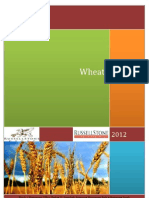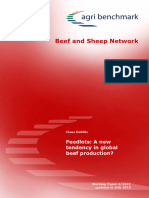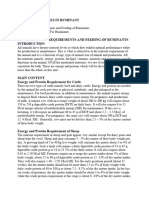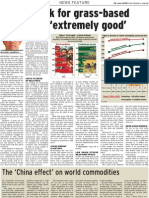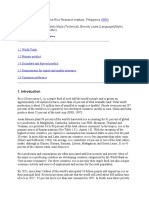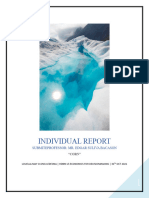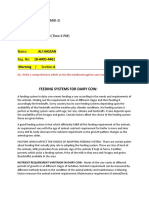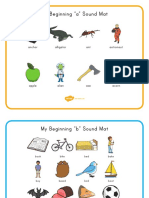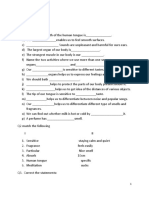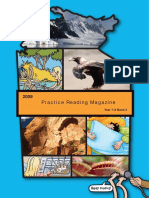Wheat
Wheat
Uploaded by
Janos David KaszasCopyright:
Available Formats
Wheat
Wheat
Uploaded by
Janos David KaszasCopyright
Available Formats
Share this document
Did you find this document useful?
Is this content inappropriate?
Copyright:
Available Formats
Wheat
Wheat
Uploaded by
Janos David KaszasCopyright:
Available Formats
RussellStone International
Safex opportunity: Wheat
2012
Block 1 Monument Office Park 71 Steenbok Avenue Monument Park Pretoria South
Introduction: Based on fluctuations in commodity pricing, wheat may become attractive in ruminant diets, replacing a portion of maize and barley in rations. Traditionally, the milling of wheat produces flour for human use and appreciable quantities of by-products for animal feeds. The Hard Winter Wheat is generally high in protein, averaging 13-15%, whereas the Soft White Wheat tends to be lower in protein, averaging 11-12%. The amino acid distribution of wheat is better than that of most cereal grains and wheat is a very palatable and digestible feed, having a relative value equivalent to corn for most animals. As with many other cereal grains, wheat is primarily a source of energy in the form of carbohydrates. Available energy expressed as either digestible energy (DE) or metabolizable energy (ME) is higher per unit of dry matter (DM) relative to corn, than other major grains Specific Feed: Swine: 1. Wheat may be used as a partial or sole grain source in diets for all classes of swine. 2. Diets containing wheat should be balanced for lysine instead of crude protein. Wheatsoybean meal diets will be higher in crude protein content than comparable corn-soybean meal diets. 3. Wheat contains more lysine than corn, thus those producers who mix their own diets using a soybean meal-premix program can save 20kg of soybean meal per ton of mixed diet 4. Those producers who mix their own diets using a complete protein-vitamin-mineral supplement should replace corn with wheat on a pound for pound basis 5. Wheat should be coarsely ground or rolled for use in swine diets 6. Wheat is worth up to 5% more than corn on an equal weight basis for those who can take advantage of wheat's higher lysine content.
Beef: Feeding wheat to ruminants requires some caution as wheat tends to be more apt than other cereal grains to cause acute indigestion in animals which are un-adapted to it. The primary problem appears to be the high gluten content of wheat which in the rumen can result in a "pasty" consistency to the rumen contents and reduced rumen motility. Whole wheat may be efficiently used by cattle, but its nutritive value is improved by some form of processing. It is generally conceded that its feeding value is optimized by dry-rolling, coarse grinding or steam-rolling to produce a thick flake. Fine grinding of wheat generally reduces the feed intake and is likely to cause acidosis and/or bloat. Never-the-less, when available for feed, it can be substituted equally for corn on the basis of TDN to a maximum of 25% of dry matter intake for beef.
1|Page
Sheep: Whole-grained wheat intended for adult sheep need not be ground or processed before incorporating into rations since these species chew feed more completely. In the case of earlyweaned and artificially-reared lambs, the palatability of whole-grain wheat is improved by pelleting. Poultry: Feed companies can use a feed enzyme that will break down the complex polysaccharides in the gut of the chicken resulting in improved energy utilization and a higher ME content in the Wheat. As stated early one of the benefits of wheat is the high protein content of around 12-14% compared to 8.5% in Corn. One of the down sides of Wheat in the Poultry industry is the increase in sudden dea th Sy ndro me ( SDS). Two a c t io n s c an be t a k e n to m i n im i z e this e ffe ct . One to supplement the diet with a meat-meal and with vitamin biotin, which is present in wheat but in an unavailable form. The second is to alter the lighting program so that the growth of the birds are slowed in the first 3 weeks and then increased in the next 3 weeks. The use of wheat in the layer industry causes the egg yolk to be a pale yellow, sometimes almost white. To the uninformed consumer the chickens and eggs fed on a wheat based diet may appear to be anemic and sick. Broiler carcass appears to be firmer when the diets are wheat based as corn contains higher amounts of fat compared to wheat
2|Page
History
In the history of the market it has only happened twice before that Corn has traded at a premium to Wheat. The mean premium that wheat should trade to Corn is about $1-00/bu. Currently the Spread is Square.
With the listing of Corn and Chicago Wheat on Safex this trade becomes an opportunity on the local market as access to the opportunity without having to open accounts in Chicago or worry about exchange rates. The contracts listed on Safex are directly derived from the prices on CBot. There are three trading options that one can use to get involved in this Spread, they are Jul, Sep and Dec. Although we suggest using a combination, in order to spread the risk and allow for a better average price. One is always able to roll open position forward to a future trading month
3|Page
Currently the Listed REDW/Corn spread for Jul is trading at a negative of around R85-00/ton.
September is trading at a premium of around R85-00/ ton 4|Page
December is trading at a premium of around R235-00/ton
The Trade The market concerns are currently that there is not enough carry over stock on Corn, this explains the increase in Maize prices on an international front. Recently the USDA world supply and demand estimates report showed that ending stocks for Maize around 125.35 mil tons adjusted from the 128.14 mil tons last month. Wheat Stocks have come in to an all-time record of 213.1 mil tons. However the high Corn prices will lead to an increase in the planting acreage, this in turn will be bearish for Corn prices and be a driving factor to rectify the norm of this spread. In order for this to be priced in one needs to note when the World Corn supply will be coming in, China and the European Union harvest corn from August to October, this consists of about 30% of the worlds production. The US which is by far the largest producer of Corn in the world, producing a staggering 39% of Worlds Corn production is harvested through October to November. It has been noted that America has planted the largest hectare age since 1940, 2.1 million hectares more than 2011. Therefore the trade will be as follows long Sep REDW short Sep CORN, then rolling forward to Dec, currently the open interest on September REDW is only 100 contracts, where December is 538. The premium at which Sep REDW is trading is currently around R100-00/ton, as the REDW is a newly listed contract only market makers are trading, they will be taking a small profit as their role as a market maker. This profit is about 1 -1.5%.
5|Page
You might also like
- My First Grammar Student Book 1 Answer KeyDocument27 pagesMy First Grammar Student Book 1 Answer Keyfree to fly0% (1)
- Evaluation of Acute Pharyngitis in Adults - UpToDateDocument11 pagesEvaluation of Acute Pharyngitis in Adults - UpToDateJavier Manuel Escobedo CalderónNo ratings yet
- Poultry Feed Formulation Manual by Thomas YegoDocument39 pagesPoultry Feed Formulation Manual by Thomas YegoMann O'nel100% (6)
- Beef Feedlot Management GuideDocument38 pagesBeef Feedlot Management GuideHassan Ali Khalid100% (2)
- Fermented Cereal ProductsDocument33 pagesFermented Cereal ProductsPratyush Eco Human100% (1)
- WheatDocument4 pagesWheatJanos David KaszasNo ratings yet
- Questions & Flour ProblemsDocument28 pagesQuestions & Flour ProblemsHaider AliNo ratings yet
- 1 Introduction and History of Dairy Development in IndiaDocument8 pages1 Introduction and History of Dairy Development in IndiaMonty KushwahaNo ratings yet
- Dairy Feeds, Part 1Document3 pagesDairy Feeds, Part 1trung dung vũNo ratings yet
- DN 054620Document7 pagesDN 054620elninolunayNo ratings yet
- A Guide To Feeding Field Peas To LivestockDocument4 pagesA Guide To Feeding Field Peas To LivestockJ Jesus Bustamante GroNo ratings yet
- Agriculture Part 2Document12 pagesAgriculture Part 2Siya AgrawalNo ratings yet
- Fooder ProductionDocument2 pagesFooder Productionghimireanu456No ratings yet
- Estatto KrollDocument2 pagesEstatto KrollKadiwala Dairy FarmNo ratings yet
- Cereals and Legume TechnologyDocument23 pagesCereals and Legume TechnologyLê Tất TiếnNo ratings yet
- ANP 505mako OOU LECTURE 2Document7 pagesANP 505mako OOU LECTURE 2Joy GbadeboNo ratings yet
- How To Feed CattleDocument27 pagesHow To Feed CattlecefaenglishNo ratings yet
- Goat GuidelinesDocument8 pagesGoat GuidelinesamjadNo ratings yet
- GrainDocument3 pagesGrainklkl mnkNo ratings yet
- Triticale Guide Stock FeedDocument2 pagesTriticale Guide Stock FeedS. Bala DahiyaNo ratings yet
- SL2264TB0603 Brown Rice - StorageDocument3 pagesSL2264TB0603 Brown Rice - StorageCleiton Soares Dos SantosNo ratings yet
- Feeding Potato Processing Waste CullsDocument3 pagesFeeding Potato Processing Waste CullsSzilard LorinczNo ratings yet
- Feeding and Management of Dairy GoatsDocument13 pagesFeeding and Management of Dairy GoatsariaNo ratings yet
- Dairy FarmingDocument8 pagesDairy FarmingGeoffrey TanuiNo ratings yet
- Animal FeedDocument12 pagesAnimal FeedjamazalaleNo ratings yet
- The Truth About Grain - Feeding Grain To Small RuminantsDocument6 pagesThe Truth About Grain - Feeding Grain To Small RuminantsqfarmsNo ratings yet
- Beef Cattle Management - With Information on Selection, Care, Breeding and Fattening of Beef Cows and BullsFrom EverandBeef Cattle Management - With Information on Selection, Care, Breeding and Fattening of Beef Cows and BullsNo ratings yet
- Silage 02Document16 pagesSilage 02api-315536698No ratings yet
- Description of Cereal ProductDocument7 pagesDescription of Cereal ProductLiyana HalimNo ratings yet
- Dairy Form PlanDocument6 pagesDairy Form Planvector dairyNo ratings yet
- Major Output - Term PaperDocument17 pagesMajor Output - Term PaperDenice Natalie RepiqueNo ratings yet
- Van Shika 12345265436Document20 pagesVan Shika 12345265436nitingupta578613No ratings yet
- Bhoole Bisre Anaj Forgotten FoodsDocument120 pagesBhoole Bisre Anaj Forgotten FoodsPRASANT KUMARNo ratings yet
- Dr. Narayan G. Hegde: Prevention of Cow Slaughter: Economic Gains As Primary ConsiderationDocument5 pagesDr. Narayan G. Hegde: Prevention of Cow Slaughter: Economic Gains As Primary ConsiderationNArendra REddyNo ratings yet
- LESSON XI CerealsDocument3 pagesLESSON XI Cerealsduang khamolNo ratings yet
- Week 2Document26 pagesWeek 2Thảo HiềnNo ratings yet
- Millet - Feeding The FutureDocument4 pagesMillet - Feeding The FutureMilling and Grain magazineNo ratings yet
- Austria APEDA Millets CatalogueDocument72 pagesAustria APEDA Millets CatalogueS.s. TamilNo ratings yet
- 1.1 Cereal GrainsDocument13 pages1.1 Cereal GrainsAraniaExumaiNo ratings yet
- Barley Grain For Ruminants - A Global Treasure or TragedyDocument10 pagesBarley Grain For Ruminants - A Global Treasure or TragedyAnkush JainNo ratings yet
- The Outlook For Grass-Based Farming Is 'Extremely Good': The 'China Effect' On World CommoditiesDocument1 pageThe Outlook For Grass-Based Farming Is 'Extremely Good': The 'China Effect' On World CommoditiesblwardNo ratings yet
- The Processing and Storage of Guinea Corn (Sorghum) in Donga Local Government Area of Taraba State.Document29 pagesThe Processing and Storage of Guinea Corn (Sorghum) in Donga Local Government Area of Taraba State.Joshua Bature Sambo100% (4)
- MeatGoat PennStDocument8 pagesMeatGoat PennStgavinilaaNo ratings yet
- Maize Value ChainDocument17 pagesMaize Value ChainPrince Oludare AkintolaNo ratings yet
- RiceDocument13 pagesRiceexsheepleNo ratings yet
- EconomicDocument23 pagesEconomiclouella.ledesma051492No ratings yet
- PROJECT PROPOSAL SampleDocument8 pagesPROJECT PROPOSAL SampleDbNo ratings yet
- Beef Products Feeds in Cow and Calf ProgrammsDocument8 pagesBeef Products Feeds in Cow and Calf Programmsharikrishnaa.vetNo ratings yet
- Swine Feed ComponentsDocument28 pagesSwine Feed ComponentsJamel Daguplo GaanNo ratings yet
- Full Hand Feeding of Sheep QuantitiesDocument8 pagesFull Hand Feeding of Sheep QuantitiesfrankyNo ratings yet
- Cattle Producti-WPS OfficeDocument2 pagesCattle Producti-WPS OfficeJ'ric ElijanNo ratings yet
- Bakery NotesDocument26 pagesBakery NotesfazalNo ratings yet
- Corn ProductionDocument12 pagesCorn ProductionAmeerah Cabangal83% (6)
- Oats Cattle FeedDocument4 pagesOats Cattle FeedDaw Moe Moe SweNo ratings yet
- Cattle Feeding-2016Document11 pagesCattle Feeding-2016ZerotheoryNo ratings yet
- Feeding Whole Soybeans To Cattl1Document2 pagesFeeding Whole Soybeans To Cattl1ZIASY ShesmerNo ratings yet
- Balancing Dairy Diet Around Forage QualityDocument3 pagesBalancing Dairy Diet Around Forage QualityJohn Honest100% (1)
- Sheep and Goat Production-1Document32 pagesSheep and Goat Production-1isiakawasiu44No ratings yet
- 18-Arid-4461 Feeding System For Dairy CowDocument6 pages18-Arid-4461 Feeding System For Dairy CowAlee HassanNo ratings yet
- ConcentrateDocument16 pagesConcentrateAnonymous o477B0N2VmNo ratings yet
- The Management of Dairy Cattle - A Collection of Articles on the Management of the Dairy FarmFrom EverandThe Management of Dairy Cattle - A Collection of Articles on the Management of the Dairy FarmRating: 5 out of 5 stars5/5 (1)
- Intravenous Fluids: Composition & UsesDocument41 pagesIntravenous Fluids: Composition & UsesFathima BanuzNo ratings yet
- Liver AnatomyDocument34 pagesLiver AnatomyAmit Kumar RanoNo ratings yet
- Estimating Size of Red and White Blood CellsDocument8 pagesEstimating Size of Red and White Blood Cellsroselapond100% (1)
- Nevada Ranch & Farm ExchangeDocument19 pagesNevada Ranch & Farm Exchangesteve.ransonNo ratings yet
- Roadkill Cafe - Triangle CongruencyDocument12 pagesRoadkill Cafe - Triangle CongruencyGeoff33% (3)
- Tinker Bell and The Legend of The NeverBeast The Chapter BookDocument51 pagesTinker Bell and The Legend of The NeverBeast The Chapter BookAveryNo ratings yet
- M9 LN Assessing Welfare in Practice PDFDocument13 pagesM9 LN Assessing Welfare in Practice PDFXz RiveraNo ratings yet
- Assigment Porifera and CoelenterataDocument10 pagesAssigment Porifera and CoelenterataMuhammad Naufal DaffaNo ratings yet
- Irshad Ahmad Cife Sea Bass and Pomfret Culture .Document12 pagesIrshad Ahmad Cife Sea Bass and Pomfret Culture .Irshad AhmadNo ratings yet
- Sexual Behaviour in Male AnimalsDocument13 pagesSexual Behaviour in Male AnimalsLitan ReangNo ratings yet
- Comparative AnatomyDocument26 pagesComparative AnatomySamantha ArdaNo ratings yet
- Beginning Sounds A-Z Word Mats PDFDocument26 pagesBeginning Sounds A-Z Word Mats PDFOksana RashevskayaNo ratings yet
- Kanji Radicals ReferenceDocument36 pagesKanji Radicals ReferenceKaren Tiemi TakaharaNo ratings yet
- 05 The Complete Far Side Volume One 1983Document88 pages05 The Complete Far Side Volume One 1983Fake AccountNo ratings yet
- 5 Teks Bahasa InggrisDocument4 pages5 Teks Bahasa InggrisIlonk Belonk100% (1)
- Kgalagadi Online Brochure 2016Document9 pagesKgalagadi Online Brochure 2016Blou BulNo ratings yet
- Scandinavian Studies Volume 85 Issue 3 2013 (Doi 10.5406/scanstud.85.3.0267) Anders Andrén - Places, Monuments, and Objects - The Past in Ancient ScandinaviaDocument21 pagesScandinavian Studies Volume 85 Issue 3 2013 (Doi 10.5406/scanstud.85.3.0267) Anders Andrén - Places, Monuments, and Objects - The Past in Ancient ScandinaviaMarioMartinPaezNo ratings yet
- Stored Food PestsDocument65 pagesStored Food Pests-No ratings yet
- EoLS - Wright (2007) OnychophoraDocument5 pagesEoLS - Wright (2007) OnychophoraNICOLAS BORJA MARTINEZNo ratings yet
- En Ak9 Elevkort The WorldDocument5 pagesEn Ak9 Elevkort The Worldsamo08001No ratings yet
- Chapter 1 My BodyDocument14 pagesChapter 1 My BodylambajituNo ratings yet
- Artículo Final - ENDOPARASITES IN FECES OF Dasyprocta Punctata FROM ARMENIA CITYDocument17 pagesArtículo Final - ENDOPARASITES IN FECES OF Dasyprocta Punctata FROM ARMENIA CITYALEXNo ratings yet
- Kelompok 5 FixDocument16 pagesKelompok 5 FixTefur Rohman Al-HabsyiNo ratings yet
- Theory, Part B - Final-InADocument72 pagesTheory, Part B - Final-InAHanifah Ainun AryanaNo ratings yet
- Dames Balochi GlossaryDocument50 pagesDames Balochi GlossaryHamid Ali BalochNo ratings yet
- Explaining - Evidence of EvolutionDocument13 pagesExplaining - Evidence of EvolutionChristopher DavisNo ratings yet
- Zhao 2017Document22 pagesZhao 2017Adrien Kyle JacintoNo ratings yet
- Reading Magazine A - Yr7Document4 pagesReading Magazine A - Yr7JeniNo ratings yet





